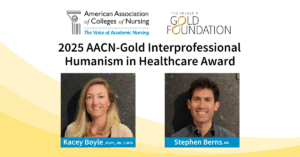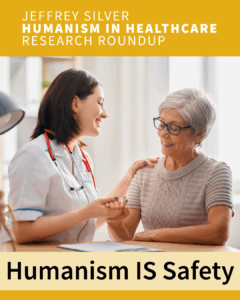As a cardiologist and a photographer, Joseph Gascho has combined those worlds into art that illuminates patients and his fellow healthcare colleagues as human beings. Dr. Gascho is a cardiologist with Penn State Heart and Vascular Institute and professor of medicine at Penn State College of Medicine. He has created many different projects over the years, spotlighting patients as people, investigating organs, honoring his non-MD colleagues who do essential support work, and sometimes penning poems that align with the photographs.
His photographs hang in the halls of the Penn State Health Milton S. Hershey Medical Center and have been featured on the cover of the Annals of Internal Medicine journal. One of his photographs won photograph of the year in 2009 for Annals of Internal Medicine. He has also published a book of poetry, “Cornfields, Cottonwoods, Seagulls and Sermons: Growing up in Nebraska.”
In 2018, Dr. Gascho was awarded the Leonard Tow Humanism in Medicine Award by the Penn State College of Medicine. Here, he shares with us how he began his journey into this art and his advice for others contemplating similar projects.
How did you begin making art around the medical experience? Where did the inspiration first come from?

One of Dr. Gascho’s projects is the “patients as people” permanent exhibit at Hershey Medical Center, which displays 10”x14” photographs of some 60 or so patients with terse medical jargon at the bottom. The medical text stands in contrast to the portraits and represents how a person can be seen as a one-dimensional patient.
That’s a tough question. I’ve been photographing since high school days, seriously photographing for a long time. In 2003, after I had been gifted, by my wife, with a then-state-of-the-art Nikon digital camera, I attended a conference that changed my whole life. “Expressing Your Spirituality Through Digital Photography” (the spirituality was very broad, not limited to traditional religious beliefs) gave me a new look at myself and my life and what mattered.
I came to see an artistic side to myself that I had neglected or deemphasized but found to be important to help me fulfill myself, and I came to realize I could meld that side with my scientific side.
My wife, a nurse and chaplain, is innately gifted with the ability to see the whole person. Her counsel and encouragement along the way has been extraordinarily important—without her, these projects would not have come into fruition. My parents were loving people who were always reaching out to others in caring ways.
It seemed a natural thing to try to combine my artistic side with an effort to recognize the humanity in others.
What is your hope in sharing your art with patients, their families and medical colleagues?
I hope that patients and families will become aware of the caring and compassion of physicians, even though sometimes it is not as apparent as would be desirable. Sometimes our feelings of compassion, in the stress of the moment, do not show, but they are there.
And I want patient and families to be aware that physicians are people, too; they have the same struggles and concerns that non-medical people do. We are all human beings.
I want my colleagues (and myself) to always remember that patients are first of all people, that there is more to them than their diseases, that we in the healthcare profession can understand them and to treat them better if we get to know them as people, not just patients.
I’d love to learn more about your “patients as people” exhibit and the “ancillary worker” exhibit.

Another of Dr. Gascho’s projects showcases “ancillary workers” in 20”x30” photographs to emphasize that non-MD support roles are as important to the institution as the deans and department heads. Each person is dressed in “Sunday best” clothes and holds an object symbolic of his or her job. The display includes the person’s name and the job they do.
I think that Rita Charon’s “Narrative Medicine” text was an important influence. She talks about the concept of “diastole” (which I, a cardiologist, so much like)—the part of the cardiac cycle when blood flows into the heart, the part of the cycle when the heart fills. Charon believes that such a diastole is essential in the doctor-patient relationship, that a physician must “take in” what the patient says, not just about his or her illness, but about other non-medical parts of their lives. Just as the heart in the next part of the cycle, systole, ejects what has come in, so the physician acts on the basis of what she or he has taken in from the patient. This taking in of all the information makes the patient into a person, someone more than a disease.
In regards to “ancillary workers,” perhaps because of my farming/blue collar background, I have often been struck by how important but unrecognized are the tasks that create the infrastructure upon which the miracles of medicine can happen. Many of these “ancillary workers” take great pride in their work, but their work is often invisible, unless looked for.
What was the workers’ reaction to the exhibit?
The workers have had very positive reactions to the display. Sometimes, as I walk along a hallway, I am approached by a worker who recognizes me and tells me how much he or she appreciates the display. Workers in some departments in fact vie for the privilege to be the one photographed!
So few hospitals or healthcare clinics show patients or staff — usually art seems to be of flowers or landscapes or something else less personal. What do you think the power is of showing the actual people working or healing?
It’s hard to get at “healing,” but I think a power of emphasizing people—patients, healthcare workers, “ancillary” workers—is that it builds teamwork, it helps to emphasize the truth that what makes a place of healing is not just the health care workers, important as they are. And by photographing faces, one sees the humanity of people, sees more that the disease. I think the power of the projects is this emphasis on humanity, of getting beyond the drugs and operations (that are all so important) because there is more to healing than drugs and operations.
What advice to you have for other hospitals or other physician photographers who might be inspired by your art to make their own art that showcases patients as people?
It takes a huge amount of commitment and proactivity on someone’s part to do this kind of thing. It has, I think, to be coordinated by someone who loves to do it. Having their photograph taken is not the highest priority on the list of many persons. As a photographer I’ve had to remind and cajole and postpone and go the second and third mile to make photographs. I initially financed much of the work myself, which I gladly did. I suspect the impetus and drive needs to come from a person who is a healthcare worker, who is aware of both the science and the art of medicine. It is also imperative to have a hospital administration that is receptive to this kind of work. I have been fortunate to have such an administration.
Have you had any surprises along the way in your journey of creating your art?
Perhaps the biggest surprise is that this whole process has, at least I hope, made me into a more complete physician, a more caring person. And I think I’ve been surprised at how meaningful to me it has been to be able to combine medicine and photography in a way that seems to speak to lots of different people.



